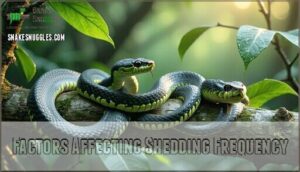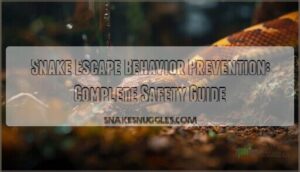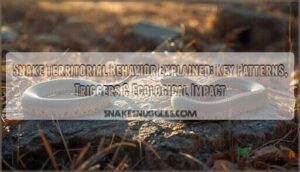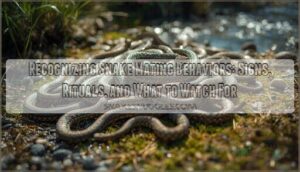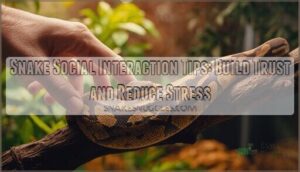This site is supported by our readers. We may earn a commission, at no cost to you, if you purchase through links.

Young snakes shed every 2-4 weeks because they’re growing like weeds, while adults typically shed every 1-3 months once they’ve reached their full size.
Ball pythons might shed monthly when young, but adult corn snakes often wait 8-12 weeks between sheds.
Think of it like outgrowing clothes – the faster they grow, the more often they need a new "outfit."
Environmental factors like temperature, humidity, and nutrition also play a role in how often do snakes shed their skin.
Understanding these patterns helps you recognize what’s normal for your serpent friend and spot when something might need attention.
Table Of Contents
- Key Takeaways
- Why Do Snakes Shed Their Skin?
- How Often Do Snakes Shed?
- Factors Affecting Shedding Frequency
- Signs a Snake is About to Shed
- Shedding Difficulties and How to Help
- Frequently Asked Questions (FAQs)
- Do snakes shed every month?
- What triggers a snake to shed?
- Do snakes go back to where they shed their skin?
- How long does it take for a snake to shed again?
- Can snakes eat while shedding?
- Do snakes shed differently in captivity versus wild?
- Are shed snake skins valuable or collectible?
- How do snakes behave differently during shedding?
- Can environmental changes trigger unexpected shedding in snakes?
- What happens to old snake skin after shedding?
- Conclusion
Key Takeaways
- Your snake’s age drives shedding frequency – juveniles shed every 2-4 weeks due to rapid growth, while adults only need to shed 3-6 times per year once they have reached maturity.
- You’ll see clear warning signs before each shed – watch for dull, milky skin and cloudy blue eyes that signal your snake is preparing to molt, plus they will become less active and refuse food.
- Environmental conditions directly impact shedding success – maintain 60-80% humidity and provide rough surfaces for rubbing to help your snake complete healthy sheds without complications.
- You should track your snake’s shedding patterns as a health indicator – consistent timing means good health, while sudden changes in frequency or incomplete sheds warrant a vet visit to rule out underlying issues.
Why Do Snakes Shed Their Skin?
You’ve probably wondered why your pet snake regularly sheds its skin like it’s changing clothes.
Snakes must shed their entire outer layer because their skin doesn’t grow with them, and this process serves several essential biological functions beyond just making room for their expanding bodies.
Growth and Body Size Changes
The primary reason snakes shed their skin is simple: their skin doesn’t grow with them.
Think of it as your snake outgrowing a sweater that never stretches – time for a complete wardrobe change!
Unlike your skin that stretches as you grow, snake skin and scales are made of keratin that can’t expand or stretch.
- Indeterminate growth: Snakes continue growing throughout their entire lives, unlike mammals that stop at maturity
- Size comparison shifts: A hatchling ball python measuring 10 inches will eventually reach 4-5 feet, requiring multiple complete skin replacements
- Body proportions change: Young snakes have different head-to-body ratios that normalize through the snake life cycle as they mature
- Weight changes trigger shedding: Rapid growth spurts increase shedding frequency, especially during peak feeding seasons when snakes pack on size quickly
Parasite Removal and Health
Beyond physical growth, your snake’s shedding process serves as nature’s pest control system.
Shedding parasites that attach to the skin can’t simply be washed away – they need complete removal through skin replacement.
This natural defense mechanism substantially impacts snake health and shedding frequency.
Poor nutrition weakens this process, while healthy shedding indicates robust immune function.
When shedding problems arise, veterinary intervention may be necessary to restore proper skin health.
Renewal of Damaged Skin
The reptile shedding process helps your snake heal from injuries and infections through scale regeneration.
When damaged skin accumulates scar tissue or develops wounds, snake shedding becomes nature’s reset button.
This healing process removes infected areas and replaces them with fresh, healthy scales, think of it as your snake’s built-in first-aid kit – the reptile molting system guarantees superior snake health by discarding compromised skin layers during healthy shedding cycles, ensuring superior snake health and a natural process of scale regeneration.
Maintaining Vibrant Colors and Patterns
Over time, your snake’s brilliant patterns can fade like old photographs left in sunlight.
The shedding cycle refreshes skin pigmentation and maintains scale iridescence that makes your pet shimmer.
Diet influence and UV exposure affect color vibrancy, while color genetics determine baseline hues.
Regular snake shedding guarantees your reptile’s natural beauty stays as striking as the day you first brought them home, thanks to the shedding cycle.
How Often Do Snakes Shed?
Snake shedding frequency depends primarily on age, with younger snakes shedding every 2-4 weeks while adults shed just 3-6 times per year.
You’ll notice this pattern because rapid juvenile growth requires frequent skin replacement, but mature snakes grow much slower and need fewer sheds.
Shedding Frequency by Age
Age dramatically impacts shedding cycles throughout your snake’s life.
Hatchling frequency peaks at every 2-4 weeks due to rapid growth spurts, while juvenile shedding occurs every 4-6 weeks as development continues.
Adult intervals stretch to 1-3 months since growth correlation weakens with age slowdown.
A proper shedding frequency indicates good health.
- Hatchlings shed like they’re bursting out of tiny clothes – growth happens that fast
- Juvenile snakes maintain regular monthly cycles as their bodies establish adult proportions
- Adult snakes space out sheds seasonally, focusing energy on maintenance over explosive growth
Species-Specific Shedding Patterns
Different snake species follow distinct shedding schedules that reflect their unique biology.
Corn snake juveniles shed every 4-6 weeks, while adults extend to 8-12 weeks.
Python shedding occurs more frequently in ball pythons—every 3-4 weeks for young ones.
Boa frequency averages 4-5 times yearly for adults.
Garter intervals can be surprisingly short at 2-3 weeks during feeding seasons.
King snake patterns typically show monthly cycles under ideal conditions, demonstrating how reptile skin renewal varies dramatically across snake species.
Corn snakes often exhibit dull scales as a shedding symptom, which is a key aspect of their biological process and unique biology.
Typical Shedding Intervals
While species-specific patterns provide a framework, understanding typical intervals helps you recognize what’s normal for your snake.
Most healthy snakes follow predictable schedules that change with age influence and environmental conditions.
Here’s what you can expect for typical shedding intervals:
- Hatchlings – Every 2-4 weeks due to rapid growth spurts
- Juveniles – Monthly intervals (4-6 weeks) with consistent patterns
- Adults – Every 1-3 months depending on species comparison factors
- Large species – 3-4 times yearly with seasonal impact variations
Diet effects and captivity influence can accelerate these timelines.
Well-fed snakes in ideal conditions often shed more frequently than their wild counterparts.
Watch for signs of shedding like dull skin and cloudy eyes – these snake behavior changes signal upcoming sheds.
Understanding these reptile skin cycles improves your snake care routine and helps you provide proper humidity when needed.
Snake owner tips include tracking shed dates to monitor your pet’s health patterns.
Factors Affecting Shedding Frequency
Several key factors determine how often your snake will shed its skin, with age being the primary driver since younger snakes grow rapidly and require frequent molting.
Environmental conditions like temperature and humidity, along with your snake’s overall health and nutrition, also play vital roles in establishing their shedding schedule.
Age and Growth Rate
Your snake’s growth rate directly controls shedding frequency, creating a predictable pattern.
Hatchling sheds occur every 2-4 weeks during rapid juvenile growth spurts.
Adult frequency drops substantially – mature snakes shed just 3-6 times yearly.
Diet influence plays a vital role; well-fed snakes grow faster and shed more often.
Watch for signs of shedding to understand your snake’s individual rhythm.
Snake care requires recognizing this age-based pattern for proper reptile care and snake behavior understanding, which is crucial for overall reptile care.
Environmental Conditions Impact
Your snake’s environment plays a starring role in how often it sheds. Temperature Effects drive the metabolic processes that control shedding frequency, while Humidity Levels determine whether your snake can complete the process successfully.
Poor Enclosure Conditions lead to irregular cycles and incomplete shed problems. Snakes shed due to factors like growth and skin wear.
- A snake in a too-cool terrarium might hold onto old skin like a stubborn sweater
- Low humidity creates a "sticky situation" where skin clings desperately to your reptile
- Seasonal Changes can trigger unexpected shedding episodes, especially for outdoor species
Health and Nutrition
Your snake’s health directly impacts its shedding schedule.
Proper reptile health requires balanced nutrition – Dietary Impact shows when snakes receive adequate vitamins versus those suffering Vitamin Deficiency.
Hydration Effects prove essential for Shed Quality, while Obesity Influence can disrupt normal cycles.
A balanced diet, including appropriately sized frozen-thawed rodents, is essential for healthy shedding.
Maintaining ideal snake habitat conditions supports regular shedding patterns.
| Health Factor | Shedding Impact |
|---|---|
| Balanced nutrition | Regular, complete sheds |
| Poor diet/illness | Irregular, patchy sheds |
| Proper hydration | Smooth skin removal |
Signs a Snake is About to Shed
You’ll notice several telltale signs when your snake is preparing to shed its skin, making this natural process easy to predict.
Your snake’s skin will turn dull and milky, while its eyes become cloudy or blue, signaling that the fascinating cycle of ecdysis is about to begin.
Changes in Skin Color
One telltale sign appears when your snake’s normally vibrant patterns become mysteriously dull and faded.
Pre-shed dullness occurs as fluid builds between old and new skin layers, creating a milky appearance that reduces pattern visibility and scale pigmentation.
This color change causes your pet to look washed-out or chalky compared to post-shed vibrancy.
The transformation signals healthy reptile health processes beginning, ensuring proper snake habitat conditions support natural shedding cycles for maximum seguridad and proteccin to achieve proper snake care and maintain healthy reptile health.
Cloudy or Bluish Eyes
You’ll notice your snake’s eyes becoming cloudy or milky blue during pre-shedding.
Eye Cap Fluid builds up between the old and new eye caps, causing this distinctive Vision Impairment.
This "Shedding Blindness" makes your snake nervous and less active.
Retained Eye Caps can occur if humidity’s too low, potentially requiring Veterinary Intervention.
Monitor this phase carefully for your snake’s seguridad y privacidad in their navegador web of environment, ensuring proper privacidad through adequate hiding spots and maintaining seguridad with ideal proteccin conditions.
Decreased Activity and Appetite
During this pre-shedding phase, your snake becomes a couch potato extraordinaire, exhibiting shedding lethargy as reduced feeding becomes the norm—they’ll often ignore their favorite meals completely.
This pre-shed behavior isn’t stubbornness; it’s smart energy conservation. Their digestive slowdown helps redirect resources toward growing new skin underneath the old layer.
Think of it as your snake’s way of saying, "I’m too busy renovating to eat right now." This is because snakes experience cloudy eyes and dull skin as they prepare to shed, which is a sign of their body’s focus on renovating and energy conservation.
Shedding Difficulties and How to Help
Even healthy snakes sometimes struggle with shedding, requiring your assistance to prevent complications like retained skin or stuck spectacles.
You can help by maintaining proper humidity levels, providing rough surfaces for rubbing, and knowing when to seek veterinary care for serious shedding problems.
Ensuring Proper Humidity
When you’ve spotted those telltale signs, it’s time to amp up the moisture levels.
Boost your enclosure’s humidity to 60-80% using a reliable hygrometer for accurate humidity monitoring.
Strategic misting techniques work wonders – lightly spray the habitat twice daily, focusing on substrate choice like cypress mulch that retains moisture naturally.
You can find various cypress mulch products online.
Your thoughtful enclosure design modifications will dramatically improve shedding success rates.
Providing Shedding Aids
Beyond maintaining ideal humidity levels, you’ll want to create physical aids that help your snake initiate and complete the shedding process. Think of these tools as nature’s equivalent of a scratching post for cats.
- Humid hide options: Place damp sphagnum moss or paper towels in a hide box to create a mini steam room
- Substrate considerations: Choose materials like cypress mulch or aspen shavings that retain moisture without becoming soggy
- Water bowl importance: Provide a large, shallow bowl that allows your snake to soak its entire body comfortably
- Rough surfaces: Add textured branches, cork bark, or rock formations that give your snake something to rub against
- Monitoring sheds: Check for complete skin removal, especially around the tail tip and eye caps where pieces commonly stick
Using proper shedding aid tools can greatly assist with this process.
Handling During Shedding
Gentle Handling during shedding is like walking on eggshells—your snake’s vision is cloudy and stress levels peak.
Avoid handling entirely unless absolutely necessary for safety check purposes. Think of it as respecting their privacy during a vulnerable time.
Snake Stress increases dramatically when disturbed during this phase. Handling Techniques should focus on security—keep interactions minimal.
Shedding Care means maintaining Humidity Control while giving them space to shed naturally without interference.
Recognizing and Addressing Shedding Problems
When your snake struggles with shedding, you’ll need to act fast. Stuck shed, or dysecdysis, creates serious health risks if left untreated. Poor Humidity Control and inadequate Snake Hydration often trigger these complications.
Watch for these warning signs:
- Patchy skin remnants clinging to body parts after shedding attempts
- Retained eye caps that appear cloudy or opaque for extended periods
- Constricted tail tips where old skin creates dangerous bands
- Persistent rubbing against surfaces without successful skin removal
Shedding Aids like lukewarm soaks and humid hides help resolve minor issues. For severe cases requiring Dysecdysis Treatment, consult a veterinarian immediately. Skin Infections can develop when retained shed restricts blood flow, making prompt intervention your snake’s safety check.
Understanding safe shedding methods is essential for preventing complications and ensuring a healthy shedding process.
Frequently Asked Questions (FAQs)
Do snakes shed every month?
Snakes don’t shed monthly like clockwork.
Juveniles shed every 4-6 weeks, while adults shed 3-6 times yearly.
Age, diet, health, and environment influence timing – growing snakes shed more frequently than mature ones.
What triggers a snake to shed?
Growth triggers shedding as your snake’s rigid keratin skin can’t stretch.
When they outgrow their current skin, fluid builds between old and new layers, creating that telltale cloudy-eyed, dull appearance that signals it’s time to molt.
Do snakes go back to where they shed their skin?
Like a nomadic traveler leaving no forwarding address, you’ll find snakes don’t return to their shedding sites.
They simply continue exploring their territory, leaving behind the discarded skin as nature’s equivalent of yesterday’s clothes, which can be seen as yesterday’s clothes.
How long does it take for a snake to shed again?
You’ll usually see your scaly friend ready to shed again anywhere from a few weeks to a few months later.
Younger snakes hit the “refresh” button more often, while adults take their sweet time between molts.
Can snakes eat while shedding?
During shedding, you’ll notice your snake typically refuses food since its cloudy eyes reduce vision and make them feel vulnerable.
They’re naturally stressed and prefer hiding until their fresh skin emerges, so don’t worry about missed meals, as this behavior is a complete and natural part of the shedding process.
Do snakes shed differently in captivity versus wild?
Ever wonder why your pet snake’s shedding seems so predictable compared to their wild cousins?
Captive snakes shed more regularly due to consistent temperature, humidity, and nutrition, while wild snakes face environmental stresses that create irregular shedding patterns.
Are shed snake skins valuable or collectible?
Shed snake skins have minimal commercial value but attract educational collectors, nature enthusiasts, and craft artists. You’ll find them priced modestly online, valued more for their natural beauty than rarity.
How do snakes behave differently during shedding?
During pre-shedding, you’ll notice your snake becomes less active, refuses food, and seeks hiding spots.
Their eyes turn cloudy blue, and they’ll rub against rough surfaces to start peeling off their old skin.
Can environmental changes trigger unexpected shedding in snakes?
Like nature’s perfectly-timed clockwork, your snake’s environment can absolutely trigger unexpected shedding cycles.
Temperature spikes, humidity changes, seasonal shifts, and even stress from habitat modifications can accelerate or delay their natural molting schedule unexpectedly, which can be influenced by various environmental factors, including stress from changes in their habitat.
What happens to old snake skin after shedding?
After shedding, you’ll find the old snake skin naturally decomposes outdoors or gets eaten by insects and small creatures.
In captivity, you’ll typically remove and dispose of it, though some keepers preserve complete sheds as educational specimens.
Conclusion
Smart snake stewardship starts with understanding how often do snakes shed throughout their lives.
You’ve learned that young snakes shed every 2-4 weeks while adults typically shed monthly to quarterly, depending on their species and environment.
By monitoring your snake’s shedding patterns, maintaining proper humidity, and recognizing pre-shed signs, you’ll guarantee healthy molting cycles.
Remember, consistent shedding frequency indicates good health, while sudden changes warrant veterinary attention for your scaly companion.
- https://pmc.ncbi.nlm.nih.gov/articles/PMC2874329/
- https://ball-pythons.net/forums/showthread.php?28794-The-Shedding-Process
- http://hillherp.com/
- http://facebook.com/hillherp/
- https://www.wilbanksreptiles.com/blogs/mastering-ball-pythons-expert-insights-for-ultimate-care/the-mysterious-shedding-habits-of-ball-pythons




